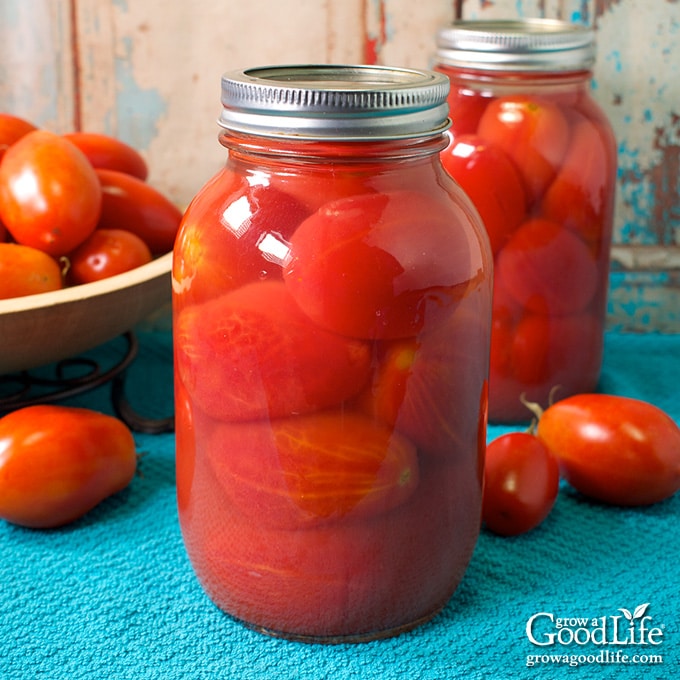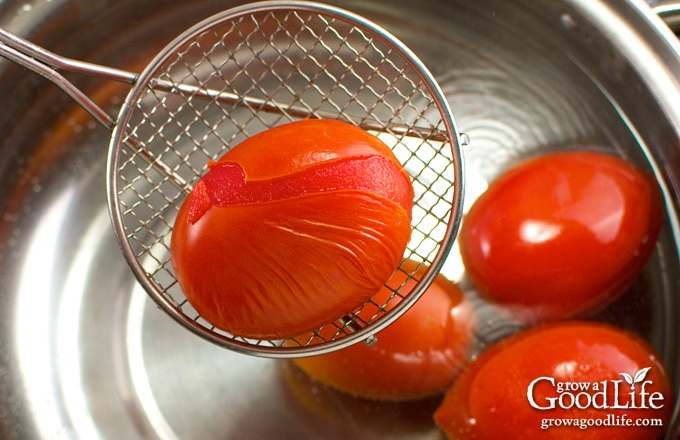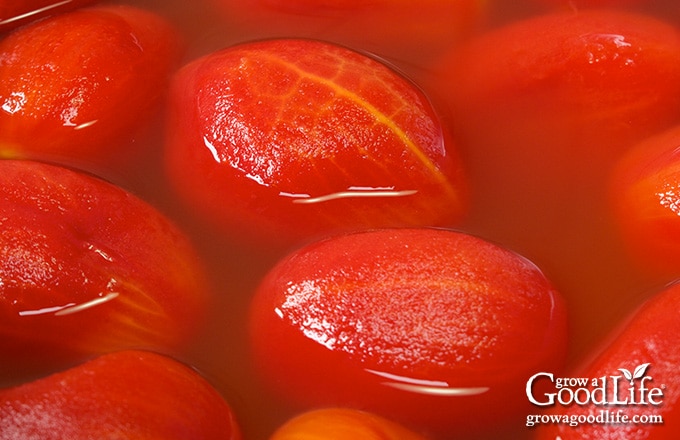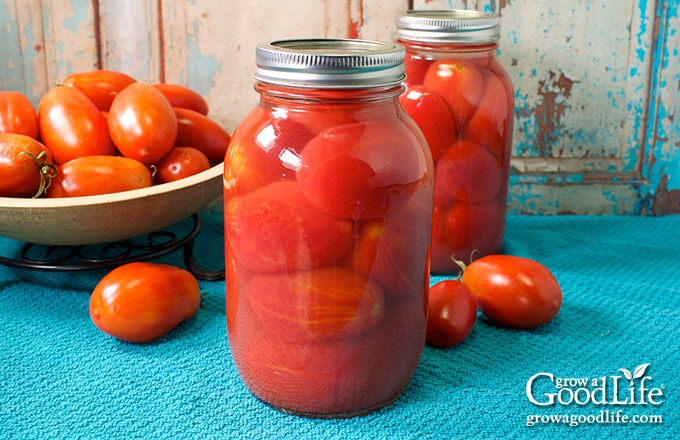Canning Tomatoes: Whole or Halved Packed in Water
This post may contain affiliate links, which means that I may receive a commission if you make a purchase using these links. As an Amazon Associate I earn from qualifying purchases.
Canning tomatoes when fresh and at peak flavor are a great way to preserve them to use all year in your favorite recipes. Use this recipe for preserving whole or halved tomatoes packed in water and processed in water bath canner for shelf stable jars.

Here in Maine, tomato season is so short. Often times, we are lucky to have a few ripe tomatoes at the end of July with the bulk of the harvest ready in August and September.
Since we enjoy tomatoes so much, I tend to grow a lot of plants in order to gather plenty of fruit to preserve for the rest of the year. Most of the tomato harvest is turned into canned tomato sauce and salsa. But there comes a point every summer when ripe tomatoes pile up on my kitchen counter, and they have to be preserved quickly to make room for the next harvest coming from the garden.
Tips for Canning Tomatoes
This home canning recipe is perfect for preserving a lot of tomatoes quickly into shelf stable jars for food storage. Whole, peeled tomatoes are ready to be opened and used in all your favorite meals that call for fresh tomatoes. Here are some tomato canning tips to help you prepare:
Choosing Tomatoes
I grow a few cherry and slicing tomatoes for fresh eating, but most of the tomatoes in my garden are paste type tomatoes for preserving. Paste tomatoes are plum shaped, with dense, meaty flesh without a lot of moisture.
- San Marzano is my favorite tomato to can whole. It has a sweet flavor, dense flesh, and very few seeds.
- Roma tomatoes are also a great canning tomato. Their size makes them easy to pack into jars, and they hold their shape well after canning. They are also a common tomato to find at your local farmers’ market if you don’t grow your own.
- Amish Paste tomatoes are large, meaty tomatoes with a delicious flavor. They are also a great choice when canning tomatoes, but you may need to cut them in half or quarters to fit in the jars.
Although these are my favorites, any type of tomatoes can be used. The moisture content is less of a concern than flavor when canning whole tomatoes. You want a tomato that tastes good, and doesn’t turn into mush when heated.
So don’t hesitate to can your favorite beefy slicing or cherry tomatoes either. Consider mixing the varieties to get a blend of flavors and textures in the jar that will elevate your cooking. You can always drain off any liquid before using.
Select good-quality tomatoes with no signs of rot or disease. Ripe tomatoes should have firm flesh that gives slightly when pressed with your thumb. Reserve softer tomatoes for sauce and salsa. Don’t use tomatoes from diseased or frost-killed vines as these may harbor harmful pathogens that may not be killed during processing.
- Tomatoes for Quart Jars: You will need about 3 pounds of tomatoes to fill each quart sized jar. Plan on about 21 pounds to fill a canner load of 7 quart sized jars.
- Tomatoes for Pint Jars: About 1 1/2 pounds of tomatoes fills a pint sized jar, so aim for 13 pounds for a canner load of 9 pints.
Acidifying Tomatoes
Additional acid is needed when canning tomatoes to ensure that the pH is at a level that prevents bacteria. There are two simple ways you can use to adjust the acidity when canning tomatoes. Add citric acid or commercial bottled lemon juice:
- Citric acid is my favorite way to acidify tomatoes because it does not affect the flavor.
- Bottled Lemon Juice: Bottled lemon juice has been uniformly acidified so there is a consistent and known acid (pH) level that is needed for safe canning. Don’t use fresh squeezed lemon juice because there is no way to know the level of acid in the juice.
Peeling Tomatoes
The most time consuming preparation when canning tomatoes is removing the skins. According to the USDA, peeling is required in order to home can the tomatoes safely.
“It’s important to follow instructions in tested recipes to ensure safety. We do not have any tested recipes that include the skins. Skins change the density of the product, so the processing time we have available would be inaccurate.” ~ Ask Extension Knowledgebase
Deciding on Raw Pack vs. Hot Pack
- Raw packing method is just as it sounds. You will pack the warm jars with uncooked peeled tomatoes, and then fill with hot water to cover. Raw packing is quicker to do. You just can’t stuff as many tomatoes into the jar, and they may be more likely to float after processing because of the air trapped in the fruit.
- Hot packing involves heating the tomatoes with hot water to cook them briefly. This helps makes them soft, so they pile into the jars easier, eliminates air pockets in the fruit, and creates a tomato-flavored liquid to fill the jars. In addition, tomatoes that are hot-packed are less likely to separate and float in the jars.
Why Tomatoes Separate in the Jars
You may have some separation with either raw pack or hot pack method, but less so with whole tomatoes that are cooked whole before filling the jars. As long as you followed a tested canning recipe, the jars are safe to use.
Separation occurs for several reasons. There may be air trapped in the fruit that causes the tomatoes to float up towards the top of the jar, and liquid to remain on the bottom. There is also an enzyme that is triggered once the tomatoes are cut and exposed to air that breaks down the natural pectin. This causes the solids to separate from the liquids.
It is the same action that occurs when you chop tomatoes, place it in a bowl, and discover a pool of liquid that wasn’t there before. That is the enzyme at work breaking down the pectin that holds the tomato’s cells together.
The enzyme is deactivated by heat. Heating the tomatoes right after peeling and canning quickly can eliminate much of the enzyme action.
Don’t Have a Water Bath Canner?
You can use a large sauce pot as long as it is tall enough to cover the tops of the jars by a few inches, and at least two more inches of air space to prevent boiling water from splashing out of the pot.
You will need to place a rack in the bottom to hold the jars up away from direct heat so they won’t break, and work in smaller batches depending on how many jars your pot will hold.
Ways to Use Canned Tomatoes
Home canned tomatoes are more flavorful than off-season tomatoes, and you won’t have the metal taste of commercially canned tomatoes. You can also use whole canned tomatoes in any recipe that calls for crushed or diced tomatoes. Just cut or crush by hand after opening the jar if you need smaller pieces.
Preserved plain tomatoes make a versatile pantry staple that can be used in many recipes, including adding to chili, stews, and soup, blending into salsa, and making a quick tomato sauce.
How to Can Tomatoes Water Bath Method
Before you begin, it may be helpful to review this factsheet on water bath canning at the National Center for Home Food Preservation website.
This is a safe caning recipe from the NCFHP website and the Ball Blue Book Guide to Preserving. The full and printable recipe can be found at the bottom of this post, but these are the steps for canning whole, halved, or quartered tomatoes packed in water.
Step 1: Prepare the Canning Equipment
Gather your canning and kitchen equipment. You will need:
- Water bath canner with a canning rack
- 7 quart sized canning jars
- Lids and bands (new lids for each jar, bands can be reused)
- Canning tools: magnetic lid lifter, jar lifter, canning funnel, ladle, and bubble popper
- Plus basic kitchen supplies such as a large pot, large prep bowls, clean kitchen towels, knife, and a cutting board.
Wash your jars, lids, and canning tools in warm, soapy water and rinse well. Inspect the jars carefully and eliminate any that have cracks or chips, because these may break in the canner.
Place the jar rack into water bath canner, set the jars in the canner. Add water to the jars first to keep them from floating, and then fill the canner with enough water to cover the jars.
Jars must be heated before filling to prevent breakage due to thermal shock. Place the jar rack into the water bath canner, set the jars upright in the canner, and add enough water to cover the jars. Bring the canner to a simmer (180˚F) for 10 minutes, and keep the jars hot until you are ready to fill them.
Follow the manufacturer’s directions for preparing the lids. Pre-heating lids is no longer necessary before using, but it is still safe to warm the lids if you want to. Just add them to the canner when you heat your jars.
Step 2: Prepare the Tomatoes
To blanch and peel the tomatoes, bring a large saucepan of water to a boil and fill a large bowl with ice water. Also see How to Peel Tomatoes for more information.
Wash the tomatoes well under clean, running water. Cut an X in the bottom and dip the tomatoes into the boiling water until the skins crack and loosen – about 30-60 seconds. Scoop them out of the boiling water and drop them into the ice water to cool.
Keep the pot on the stove over low heat. Depending on which packing method you choose, you will use this water to fill your jars and/or heat your tomatoes.
Remove the skins from the tomatoes once they are cool enough to handle. Cut out the cores, and leave whole, or cut in halves or quarters as desired.

Step 3: Can the Tomatoes
Lay a kitchen towel on the counter, and place the citric acid or lemon juice, canning salt (if using) nearby along with the measuring spoons. Fill the jars using the raw pack or hot pack method as described below:
Raw Pack
Bring the blanching pot of water back to a boil. Use the jar lifter to remove a hot jar from the canner, drain, and place on the towel. Keep the remaining jars in the canner, so they stay warm.
Add the citric acid or lemon juice to each jar, salt (if using), and then fill the jars with the prepared raw tomatoes. Ladle the boiling water over the tomatoes leaving a 1/2-inch headspace.
Run the bubble popper through the jar to release air. Wipe the rim with a damp towel to remove residue. Center a lid on the jar, place the band over the lid, and screw it on until fingertip tight. Place the jar back into the canner, and repeat with the rest of the jars.
Hot Pack
Add the prepared tomatoes back to the pot of water on the stove. Adjust water if necessary so that it is covering the tomatoes. Bring the pot back to a boil, reduce the heat to a gentle boil, and cook the tomatoes for 5 minutes.

Remove a hot jar from the canner, drain, and place on the towel. Keep the remaining jars in the canner, so they stay warm. Add the citric acid or lemon juice to each jar. Add the salt for flavor if desired. Fill hot jars with the hot tomatoes leaving a 1/2-inch headspace at the top of the jar.

Add enough cooking liquid to cover the tomatoes, maintaining a 1/2-inch headspace. Run a bubble popper through the jars to release air bubbles. Wipe the rim with a damp towel to remove residue. Center a lid on the jar, place the band over the lid, and screw it on until fingertip tight. Place the jar back into the canner, and repeat with the rest of the jars.
Once the jars are all in the canner, adjust the water level so it is covering the jars by several inches, bring the pot to a boil, and process the jars for the times indicated in the recipe below. Let the jars cool, test the seals, label and date the jars, and store in a cool, dark location for 12 to 18 months.

Canning Tomatoes: Whole or Halved Packed in Water
Ingredients
- 21 pounds tomatoes for 7 quart sized jars. See note for pint jars below
- 2 gallons water for blanching plus extra for filling canner
- 2 trays of ice cubes
- citric acid or bottled lemon juice
- canning salt optional for flavor
Instructions
Prepare the Canning Equipment
- Wash your jars, lids, screw bands, and canning tools in hot soapy water. Rinse well to remove all suds. Set aside to air dry on a clean kitchen towel.
- Place the jar rack into water bath canner, place jars in the canner, and add water to cover. Bring the canner to a simmer (180˚F) for 10 minutes, and keep the jars hot until you are ready to fill them.
Prepare the Tomatoes
- To blanch and peel your tomatoes, add about one gallon of water to a large saucepot, cover, and bring to a boil over high heat.
- Fill a large bowl with the second gallon of water and several trays of ice.
- Wash the tomatoes well under clean, running water. While working in batches, cut an X in the bottom and dip the tomatoes into the boiling water until the skins crack and loosen, about 30 to 60 seconds.
- Once they crack, scoop them out of the boiling water and drop them into the ice water to cool.
- Keep the pot on the stove. Depending on which packing method you choose, you will use this water to fill your jars and/or heat your tomatoes.
- Once the tomatoes are cool enough to handle, remove the skins, cut out the cores, and leave whole or cut in halves or quarters as desired.
- Fill the jars using the raw pack or hot pack method as described below.
Fill the Jars: Raw Pack
- Bring the large pot of water back to a boil over high heat.
- Spread a kitchen towel on the counter. Use your jar lifter to remove a jar from canner, drain, and place on the towel. Keep the remaining jars in the canner so they stay hot.
- Add 1/2-teaspoon citric acid or 2 tablespoons lemon juice to each quart sized jar (1/4-teaspoon citric acid or 1 tablespoon lemon juice for pints).
- Add up to 1 teaspoon of salt per quart to the jars (1/2 teaspoon for pints), if desired for flavor.
- Pack the raw tomatoes into the jar leaving a 1/2-inch headspace.
- Use the jar funnel and ladle to cover the tomatoes with boiling water, leaving a 1/2-inch headspace.
Fill the Jars: Hot Pack
- Add the prepared tomatoes back to the pot of water on the stove. Adjust water if necessary so that it is barely covering the tomatoes. Bring the pot back to a boil, reduce the heat to a gentle boil, and cook the tomatoes for 5 minutes.
- Spread a kitchen towel on the counter. Use your jar lifter to remove a jar from canner, drain, and place on the towel. Keep the remaining jars in the canner so they stay hot.
- Add 1/2-teaspoon citric acid or 2 tablespoons lemon juice to each quart sized jar (1/4-teaspoon citric acid or 1 tablespoon lemon juice for pints).
- Add up to 1 teaspoon of salt per quart to the jars (1/2 teaspoon for pints), if desired for flavor.
- Use the jar funnel and ladle to fill the jars with the cooked tomatoes. Ladle hot cooking liquid over the tomatoes, and leave a 1/2-inch headspace.
Can the Tomatoes
- Run the bubble popper through the jar to release air. Wipe the rim clean with a damp paper towel.
- Center a lid on the jar, and screw on the band until it is fingertip tight. Use the jar lifter to place the jar back into the canner, and repeat with the remaining jars.
- Once all the jars are in canner, adjust the water level so it is two inches above the jar tops. Adjust the space in between the jars to allow hot water to circulate.
- Cover the canner and bring to boil over high heat. Once water boils vigorously, continue boiling quart size jars for 45 minutes (40 minutes for pint jars) at altitudes of less than 1,000 feet. Adjust processing time for your altitude if necessary. (See notes).
- When processing time is complete, turn off the heat and let the canner to cool and settle for about 5 minutes.
- Spread a dry kitchen towel on the counter. Remove the cover by tilting lid away from you so that steam does not burn your face.
- Use the jar lifter to lift jars carefully from canner and place on the towel. Keep the jars upright, and don't tighten bands or check the seals yet. Let the jars sit undisturbed for 12 to 24-hours to cool.
- After the jars have cooled for at least 12 hours, check to be sure jar lids have sealed by pushing on the center of the lid. The lid should not pop up. If the lid flexes up and down, it did not seal. Refrigerate the jar and use within a week.
- Remove the ring bands, wash, label, date the jars, and store the canned tomatoes in a cool, dark location between 50 to 70 degrees F for 12 to 18 months. Once the jar is open, refrigerate and use up within a week. Yields about 7 quarts of whole tomatoes.
Notes
- Quarts at altitudes of 1,001 – 3,000 ft. is 50 minutes, 3,001 – 6,000 ft. is 55 minutes, and above 6,000 feet is 60 minutes.
- Pints at altitudes of 1,001 – 3,000 ft. is 45 minutes, 3,001 – 6,000 ft. is 50 minutes, and above 6,000 feet is 55 minutes.
Nutrition
Other Ways to Preserve Tomatoes:
- Seasoned Tomato Sauce
- How to Can Crushed Tomatoes
- Tomato Jalapeño Salsa
- Sun Dried Tomatoes
- Roasted Roma Pizza Sauce
- Tomato Vegetable Juice
40+ Meals in a Jar Pressure Canning Recipes
In this eBook, you will find 50 pressure canning recipes, including 44 meals, along with homemade stocks and bone broths. Recipes include soups, stews, chilis, beans, beef, pork, and poultry. Explore the world of preserving delicious home-cooked meals for all seasons.



I cold packed and they are sealed but some of them the tomatoes are out of the water because it is now down a couple of inches. Are they safe to leave like that or do I redo them? Did I do something wrong?
Christina, Did you follow this recipe? It calls for raw pack or hot pack. With either method, you start with warm jars and a warm canner. Cold pack refers to cold food, cold jars, and cold canner. If you cold packed, your tomatoes were not processed properly and could be unsafe.
If you followed the recipe and raw packed your tomatoes into warm jars and less than half of the liquid is lost, but the jars are sealed, the tomatoes are still safe for shelf storage. The lower liquid can be caused by air in the tomatoes or siphoning. The tomatoes not covered by the liquid will darken, so use these jars first.
I wanted to see how to keep the Roma tomatoes whole and not turn all mushy when canning???
Kristy, Keeping Roma tomatoes completely whole during canning is quite challenging. I’ve found that using very firm Roma tomatoes and the raw packing method can help. This involves packing warm jars with uncooked peeled tomatoes and filling them with hot water before processing in a water bath canner.